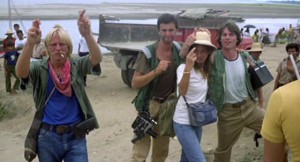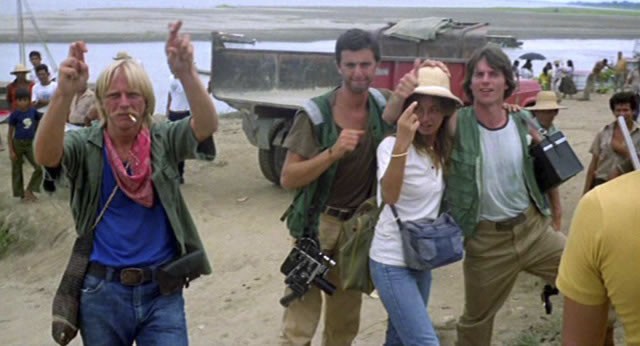
And here will be trigger warnings and spoilers. Though while watching it last night, in emotional preparation for the release of Eli Roth’s The Green Inferno, I realized there’s no real way to spoil this film. To watch it with even modest knowledge of where its going, Cannibal Holocaust remains a thoroughly rotten experience.
It took a minute to find my dvd, given to me years ago as a gift, because I shelved it (read: hidden it) in the closet. Years before that, I attended a screening of Ruggero Deodato’s legendary Cannibal Holocaust, back when it was only written of parenthetically by critics or the curious and brave. I wanted to know what this was, how bad it could be, and what could justify its poster at the time, that of a person impaled like a pig on a wooden stake. After speaking of that screening with a friend, he found and bought a copy of it for me and gave it to me, in the same way you’d hand a dead rat to your mother.
Cannibal Holocaust was always intended to be an exploitative, button pushing piece of work and admits so up front. Released in 1980, it came near the end of grindhouse / exploitation era of films where filmmakers gleefully showered their crime and sex fueled stories with gore and explicit nudity. The film opens with a long text crawl, to be seen as warning or apology. “The following motion picture contains scenes of extreme violence and cruelty,” it reads before calling on free speech and quoting Thomas Jefferson. “What you will see will definitely shock and offend you.” It goes on. “Nonetheless, it should be viewed as a disturbing historical document of a bygone era of extreme irresponsibility which no longer exists, and, hopefully, will never exist again.”
And we’re off – beginning with a helicopter shot over the chocolaty waters of the Columbian rainforest and, quite frankly, one of the most lovely and melodic opening themes for a movie. Not since A Summer Place has a film had such a gorgeous opening title.
The film quickly juxtaposes the raw Amazonian jungle with the city jungle of New York and tosses us into the plot. A small group of filmmakers shooting a documentary in the rainforest on cannibal tribes have gone missing. An anthropology professor Harold Monroe (Robert Kerman) agrees to lead a rescue mission to find them and the footage they shot. Before he arrives, the military stages a raid on one tribe out having lunch in the bush by viciously mowing them down and kidnapping one of their members to use later as a negotiating tool.
After Professor Monroe arrives, he meets up with his guides and they venture into the rainforest. They find themselves caught between two primitive tribes, the tree-dwelling Yanomamo and the river people, the Shamatari. Once one of the guides gains the trust of the river people by bathing naked in the muddied water, they promptly lead them to a shrine built with the remains of the missing filmmakers. The Professor is able to get the undeveloped film from the tribes people and return with it to New York. Back in the states, he screens the footage for several tv executives who at first encourage the professor to show the recovered film as a documentary. But they calmly screen the unedited reels to see what really happened in the jungle.
What happens is a Grand Guignol level of depravity. As a film, Holocaust is gruesome, xenophobic and sexist. Several real animals are killed on screen, including one curiously long scene of a live turtle being de-shelled and butchered. Those monkeys seen early in the film prancing in the trees as if escaped from a Terrence Malick film, do not come to a good end. By todays standards, those killings read as a pointless cinematic sacrifice with the camera patiently waiting for the flow of blood. Before watching a naked woman dragged by a rope through the mud to be sexually assaulted and murdered, Professor Monroe’s guide tells him to “sit back and enjoy the show”.
“The show” Cannibal Holocaust offers is awful if not just challenging, um, entertainment. The sequence mentioned above is staged like perverted performance art, without much art. It’s a film that doesn’t aim to be pleasant nor does it want to be enjoyed as a good movie. It’s theater of blood and violence, with a heaping helping of hatred for women. As women are, naturally, the film’s most reliable victim. Of course a pregnant villager gets stoned to death. But men get their share of full frontal nudity and genital mutilation too, don’t get me wrong. When one character strips naked and jumps in the river to show the villagers he can be trusted, he’s rewarded with a half dozen giggling naked tribes-girls who suddenly emerge from the bush and swarm him with tickles and giggles before leading him and the others to their shrine of human bones.
Or consider: When the rape of a village girl staged in a mud pit gets interrupted by the kinda-disapproving shouts of the film crews only female member, (Francesca Ciardi) she’s tossed onto the grass and the film reel the tv execs are watching of it breaks and stops. On to the next.
To some extent, Cannibal Holocaust attempts to aim for a kind of social commentary. From the tribespeople’s (and audience’s) perspective, it’s the white man who is the real and most cruel savage. The film uses the New York sequences to balance its immorality and argue with itself, admitting aloud that the footage we’re watching is offensive and inhumane. Only to then smash cut back to more of it.
During one sequence where the filmmakers purposefully torch the village, it feels as if the film wants to respond to the violence and cruel indifference of the Vietnam war. (One crew member turns to camera: “Things like this happen all the time in the jungle. Its survival of the fittest. In the jungle, the daily violence of the strong overcoming the weak!”) And immediately afterwards, two from the filmmaking team have sex in one of the burned out husks left over while the villagers sit on the beach behind them watching.
Thirty years later, seen by todays standards and activism, its even more unwatchable than it was when it was new. The films lush photography and awe-inspired shots of the Yanomamo’s tree house is wasted and would be better used in another film. The tribes people seem missing even the sub-dignity of stereotypes. They are reduced to random, non-sensical choreography and grunting. They are never seen as human or people, but something closer to animals.
If the film didn’t work so hard in support of its offensive and exploitative goals, it could have worked as a solid horror film. As is, its just as happy being a celebration of gore, death and cruelty that’s unrelenting and free of morality or drama. There is though some historical significance validating the existence of Cannibal Holocaust. It comes from an era of the legend of the 1970’s snuff film serving’real’ deaths with a side of porn. The film-within-a-film we briefly see here, entitled The Last Road to Hell (allegedly the film the documentarians made before they disappeared) resembles the Mondo Cane series of films made by another group of Italian filmmakers. Referred to as a ‘documentary’ its more accurately filmed executions and aftermath of various international coups. Death staged for entertainment.
And note that Cannibal Holocaust hit theaters a couple of years before the first Sony Camcorder hit the home video market. Once Holocaust shifts into its ‘found footage’ section, you can see the origin of ideas for The Blair Witch Project or The Last Exorcism. One can see here the future of Eli Roth and torture porn. What kind of work would Gaspar Noe, Lars Von Trier, Michael Haneke make if there’d never been a Cannibal Holocaust that taunts viewers while they’re watching it? I thought of several flicks that deeply troubled me, films I hated because of their attitude towards me as an audience and how they, as Roger Ebert once wrote, ‘go about their business.’ Before asking myself at the end of the screening, ‘what was the point of that,’ I felt I needed to be baptized or at least sit through a marathon of cartoons.
At the end of the Cannibal Holocaust, one of the TV executives places a call to someone off-screen. “John, I want this video burned. All of it.” The film itself seems to announce to you, the audience having endured it, that its sorry it exists. If you stayed past the opening text crawl, right there is your moral. The exec hangs up the phone and quietly walks out of the screening room.
Professor Monroe, meanwhile, leaves the building for the streets of New York and lights his pipe at the exit. He thinks aloud: “…We wonder who the real cannibals are” then crosses the street towards the World Trade Center. Roll Credits.

